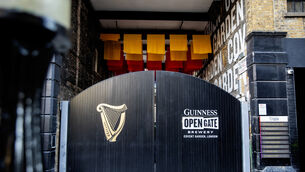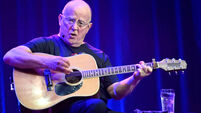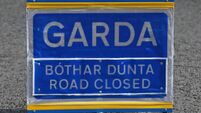Give PE a sporting chance in schools

Students may think they are being creative geniuses but excuses for avoiding PE rarely warrant more than a D grade.
Brendan O’Malley, for one, is hard to impress. “Students don’t forget their gear,” he says. “Students are actively leaving their gear after them because they hate PE. It’s the same way they forget to bring in their compass for technical graphics. They don’t forget — they’re just looking for a way out.”
At O’Fiaich College in Dundalk where Brendan teaches PE, the plague of ‘forgetfulness’ has been on the wane thanks to a shake-up of the syllabus, latitude on timetables and some truly creative thinking.
But the Physical Education Association of Ireland of which Brendan is president believes more work needs to be done to counteract students’ negative perceptions of PE. And fast.
With lifestyles becoming increasingly sedentary and obesity on the rise, along with the associated problems of heart disease, type-2 diabetes and various cancers, all the expert advice is to get children physically active and keep them active into adulthood.
Children start off their schooldays barely able to keep still so why isn’t PE harnessing and holding onto that innate urge to keep moving?
An exercise under way by the Department of Transport, Tourism and Sports may provide some insights. It suggests that not only does PE get too little time in schools but it gets too much sports.
The Department is drawing up a National Sports Policy and it issued a consultation paper seeking submissions on what it should contain. It prompted warnings that when it comes to children, there may be too much emphasis on sport.
The Curriculum and Assessment Policy Unit (CAP) of the Department of Education said even using the term ‘sport’ in schools can be counterproductive. CAP’s submission said: “The document certainly implies that [the definition of sport] is narrower than what the Department of Education and Skills would like — ie that it needs a broader physical activity emphasis.
“The inference in the document is very much around competitive sport, and weighted towards competitive team sports. ‘Sport’ can actually be an off-putting notion for many children and young people where it is associated with excessive competitiveness and exclusivity.”
On the issue of getting the established sports bodies more involved in schools, it said: “The potential for getting the sports sector to provide more support for sport in schools is worth exploring, but should not involve promoting competitive or contact sport (invasion games in particular) over other forms of potentially life-long physical activity.”
An invasion game is one where the aim is to attack an opponent’s territory and score points or goals — Gaelic games, soccer, rugby, hockey and basketball being prime examples and much beloved of Irish schools.
The Department of Health offered a similar assessment, noting the finding of a Department of Children and Youth Affairs consultation with children in relation to healthy lifestyles.
It reported: “In particular, it was noted by young people that few alternatives to team sports were offered during PE classes...it is clear that many children are unhappy with the range of sports which are offered.”
Brendan O’Malley is a basketball fan and coaches the school team outside of class time but he agrees with the views offered, not least because of his own experience in school where “all we did was play soccer”. That’s fine if you like soccer and are good at it. But if you don’t and aren’t or even if you have the love, but not the genes, for it, then PE will stand for painful experience.
“Students who are participating in sport after the age of 13 or 14 will often be participating at a very high level because they’ll be playing for the county or a club as well so a lot of the average players drop off,” he says. “They get limited playing time on the pitch and after a year or two of that they just throw in the towel.
“Another thing is, in mixed schools, the boys seem to dominate the classes, in particular team sports and invasion games, so I avoid them.”
In their place, Brendan offers pilates, zumba, sports science, athletics and a mix of exercise and games. He does teach some basketball but he focuses on the skills and movement aspects and limits any match time to five or 10 minutes at the end of the session.
And because teenagers love their iPads, he incorporates those too. “That sounds strange because we see them as the enemy of physical activity but I use them to motivate students. So for instance, for my last class, the students put heart rate monitors on, did some circuit training, and all the information from the monitor was sent on to their own iPad so they could track their heart rate throughout and we could have a conversation about it afterwards.
“For every pro there’s a con — at lunchtime we see students just sitting inside on their iPad instead of going outside. But equally, there are a few girls who never do PE so I put them in charge of gathering the information and one of them said to me, I’m going to bring in my gear next week and monitor my own heart. Attitudes can change.”
O’Fiaich College is supporting change. For a six-week module during which Brendan’s students used an external gym once a week for a double class in the afternoon, they were allowed miss the last class of the day — religion — to give extra time for travel.
“You’re very limited in what you can do if you don’t have flexibility. In a double class of 80 minutes, you’re taking away 10 minutes to get changed at the start and 10 minutes at the end so you’re down to an hour before you do anything. Then you’ve to take a roll call and you have to do a recap so you only have about 45 minutes activity a week when you’d want a minimum of 45 minutes a day.”
Change also has to be driven by the Department of Education, he says, and so far, it has been less than dynamic. PE is not compulsory at senior cycle in secondary schools and until a few weeks ago there wasn’t even a standard curriculum for teachers to follow.
“It has been mainly ad-hoc and while there is a lot of good work going on in individual schools, it says a lot about the attitude of the department when there isn’t even a curriculum. We now have one that is available for teachers to start using from September 2017. Again it’s optional, which is worrying, but at least it’s structured.”

The Department has also been working on making PE an optional Leaving Cert exam subject — since the 1980s. “There is a syllabus and it has been passed by the NCCA (National Council for Curriculum and Assessment) and we are eagerly awaiting its implementation,” says Brendan.
“When it was decided to make political studies a Leaving Cert subject, the syllabus was written, published, rolled out and in schools within 18 months. This Leaving Cert PE curriculum has been in development for the past 34 years.”
When asked about a roll-out schedule and training arrangements for the introduction of PE as an exam subject, the department said: “A plan to implement these is under development. Further information will be available in due course.”
For Brendan, it’s the kind of answer that ranks with forgetting your gym gear. “The Government are afraid of their lives of rolling it out, that’s the truth of it,” he says. “You might have to hire an extra PE teacher or get other resources and nobody in the Government wants to spend money on it.
“What’s really frustrating for a PE teacher is that every time you turn on the news you hear that students are not doing enough, that they’re sedentary, that obesity levels are rising — all that kind of thing — and the Government is drawing up action plans and policies. All of that is only rhetoric if it isn’t put into action.”
But if the problems with PE are most obvious at second level, they often begin in primary school. “We have a lot of students coming into second level who have no idea how to run, how to catch, throw, jump, hop,” Brendan says.
“A primary school teacher has to be an expert in 30 different areas and they can’t be a master of all of them. Some primary school teachers may prefer music and they do extra music, or they may prefer Irish so they lean towards Irish. They may hate sport themselves and they don’t do it and there’s no comeback, no accountability.
“My suggestion would be that specialised PE teachers go into primary schools. You could have one qualified PE teacher in a large school or one split up between a few small schools and that would make a big difference to the quality and consistency of teaching.
“If we had that from day one, all the way through school, with four classes a week minimum plus an option to study PE for the Leaving Cert, it would be a completely different society.”
Policy submissions on sport in schools

The National Sports Policy* consultation paper is a wide-ranging document, looking at the health, tourism, safety, and funding aspects of sport among others.
It stresses the importance of getting and keeping pupils involved, potentially through greater engagement with sporting bodies.
In total, 50 submissions were received. Here’s what some of them said about children, schools, and sport.
Sport Ireland
“There is the possibility that sports bodies are overly involved in the provision of sport in schools as a substitute for, rather than as a support to, the teaching profession. We believe that the development of a physically literate cohort of younger people should primarily be a matter for a well-resourced, well-trained teaching profession to implement the PE curriculum as envisaged and where sufficient time is allocated towards it across all schools.”
Curriculum and Assessment Policy Unit, Department of Education
“Where schools place significant emphasis on one or two competitive sports, it is vital that such emphasis does not diminish the place of other sports, or of genuine physical education, on the curriculum or in the life of the school. The question might well be asked, is there a link between [high drop-out rates] and an over- emphasis on competitive sport in teenage years, in school and outside, causing burnout? This is the sort of trend which needs to be reversed.”
UL Beo Initiative, Physical Education and Sports Sciences Department, University of Limerick
“With the best of intentions, the research we have to date suggests that in Irish primary schools, GAA has become the PE/sporting environment. This is not a strategy that will encourage more young people to be involved. There has to be an investment beyond the Big Three (FAI, IRFU, GAA). While there is a return on investment from engaging with agencies that have an infrastructure, this is a short-term gain.”
Gordon Brett, Niamh Ní Cheilleachair and Kieran Dowd, Department of Sport and Health Sciences, Athlone Institute of Technology
“The provision of physical education in primary education is insufficient. Teachers qualifying from teacher education institutes are not receiving sufficient training in this area, while qualified teachers that may have received such training during undergraduate training are unlikely to have upskilled or completed any CPD [continuing professional development] in this area since graduation.”
Department of Health
“The potential exists to develop initiatives that are of interest to children that are less interested in competitive or in team-based sport.”
Irish Rugby Football Union
“There is a need for stronger policies regarding the amount of physical activity which schools are required to deliver, enhanced teacher training at education level, and the allocation of designated PE teachers in primary and secondary schools. Better training for teachers, both preparatory and in- service, better collaboration between schools and community clubs for the provision of facilities and coaching, and better alignment between school curriculum and NGB [sports’ national governing boards] programmes, would help ingrain sport and physical activity into the psyche of the pupil.”
Gaelic Athletic Association
“Very often success in a sporting context is judged on the basis of ‘winning’, however, it will be necessary to rethink the parameters of measuring the impact of the policy framework. Imagine the difference to Irish society if by 2027, 90% of children and young people were getting the recommended amount of daily physical activity or if 90% of primary and post primary pupils were receiving the recommended one to two hours a week of PE at school.”
Swim Ireland
“Of all sporting activities, swimming is best able to retain and attract participants over the life course. Swimming is the second-most popular activity taken up as a child and still participated in as an adult. It is the most popular sporting activity taken up as an adult. Of the popular children’s sporting activities swimming suffers the least drop-off in participation during the volatile early adult years (18-22). Whilst we believe strongly in the benefits of all sports, we emphasise the importance of swimming which we believe to be underestimated in the current ranking system of Government support to sport, particularly in relation to current funding.”
Football Association of Ireland
“Player drop-out is a common theme across all sporting codes and a ‘winning at all costs’ mentality, largely driven by coaches and parents, inhibits player development and can lead to a sense of frustration, failure and ultimately drop-out. For children in any sport the match result must be secondary to the quality of play and the enjoyment of playing. It is essential that young players are free from the constant pressure of winning and are allowed freedom of expression on the pitch.
“Minimum playing time at a young age should apply across all team sports — players won’t develop unless they get game time. We believe it would be hugely beneficial to support initiatives by NGBs involved in team sports to develop resource materials to educate coaches and parents as to the importance of player development at young ages with a view to eliminating the ‘winning at all costs’ mentality.”















